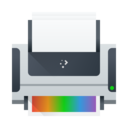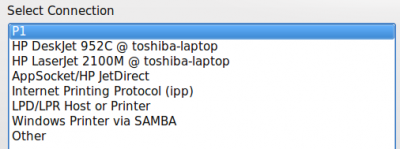Configuration du système/Imprimantes
Configuration de l'imprimante
 |
Utiliser cet outil pour connecter votre ordinateur à une imprimante et configurer des options appropriées |
Liste des fonctionnalités
- Ajouter une imprimante à votre ordinateur
- Donner un nom approprié à chaque imprimante pour mieux l'identifier
- Effectue des tests pour l'imprimante ainsi que de la maintenance
- Enlever une imprimante

Lorsqu'une imprimante n'est pas connectée directement à votre ordinateur avec un câble USB, vous devrez utiliser l'utilitaire Configuration de l'imprimante pour ajouter l'imprimante, par exemple lorsqu'un autre ordinateur a partagé une imprimante ou que vous souhaitez vous connecter. directement à une imprimante connectée à un serveur d'impression.
Exemple
Suivez ces exemples d'étapes pour ajouter à votre ordinateur une imprimante connectée au réseau. Tout d’abord, rassemblez les informations sur votre imprimante avant de commencer (marque, modèle, numéro IP, etc.).
Getting to the program is a sequence of straightforward steps.
- KDE
- Once you get to the tool, click the button to add a printer (Find and click the button between steps.)
- Your computer will search your local area network for printers that have been shared on other computers or are directly attached to the network.
In this example, I have an HP Laserjet 2100M which is connected directly to my network using a small print server on the printer.
The next illustration also shows that I have another computer sharing two printers on a Toshiba laptop. If I wanted to use either of them, that other computer would need to be on for the printer to work. Remote printers work best if directly connected to the network or are connected to a dedicated print server computer.

- I choose which is the choice for my printserver.

- I enter the IP address number in the Host blank (Currently, the Printer Configuration tool does not identify what that number is, so you will need to ask your network administrator what the IP address is).
- Choose the manufacturer (Mine is HP)
- Choose the model (HP has many)
- Choose the recommended Driver unless you have a reason to do otherwise.
- Give the printer a useful name since "printer" may not be good enough.
- Give a description including the physical location if not in your own room.
- The "Location" defaults to your computer's name in case you decide to share it later. Sharing is one of the options of the printer configuration tool.
On the configuration screen, you will now see a new "Local Printer" because the printer is "attached" to your computer. If you have more than one printer, you should be sure to thoughtfully select one as the default. You might not want to set the big high-speed departmental printer/copier in the department manager's office as your default if you have a small printer hooked directly to your computer.


